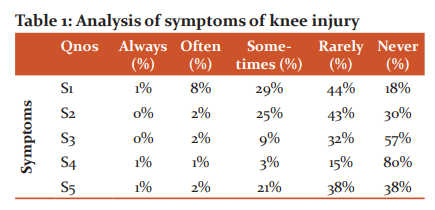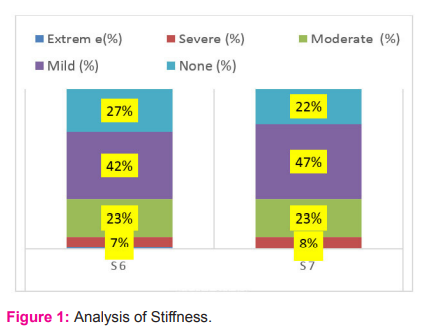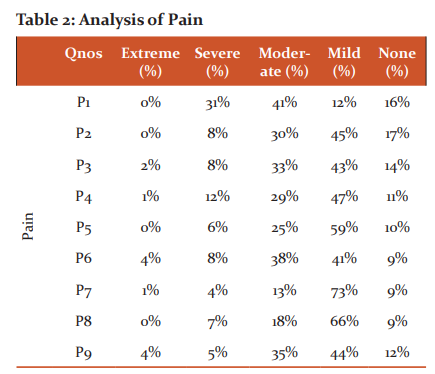IJCRR - 14(7), April, 2022
Pages: 01-05
Date of Publication: 05-Apr-2022
Print Article
Download XML Download PDF
Functional Status and Quality of Life of Judokas Due to Knee Injury
Author: Deptee Warikoo, Harshita Raghu, Lovish Gupta
Category: Healthcare
Abstract:Introduction: Judo, is a primarily a sport. The objective is to master the opponent. This is mainly done by applying pressure to arm joints or to the neck to cause the opponent to yield. This format of play leads to a ligament tear due to a direct blow to the knee, either from a fellow athlete or the judo mats. Injuries mainly occur due to a poorly executed throw or bad falling technique. The knee usually buckles and pain is severe. This knee injury affects the players badly. Objectives: To find the percentage of knee injury and affection on functional status and quality of life of judokas. Methods: Based on inclusion and exclusion criteria 100 subjects were enrolled for the study of purposive sampling. Judokas filled the set of questionnaire about knee injury and osteoarthritis outcome score. Results: Data was meaningfully assorted through calculation of mean, median and standard deviation. Value of mean is 55.48, median is 56 and standard deviation is 26.976. Conclusion: The conclusion of the study is that 51% of the players have mild effect on their functional status and quality of life due to knee injury during their practice session followed by moderate 45% and only 4% of population has severe effect on their functional status and quality of life during and after their practice sessions.
Keywords: Functional status, Quality of life, Disability, Physiotherapy, Practice session and Judokas.
Full Text:
INTRODUCTION
According to Burdick D1 Judo, Japanese j?d?, is a system of unarmed combat, now primarily a sport. Techniques are generally intended to turn an opponent’s force to one’s own advantage rather than to oppose it directly.
Judo is a highly technical sport based on the principle of “maximum efficiency with minimum effort". A judo fight starts with the opponents both standing, attempting to throw each other off balance. After a throw, judokas transition to ground-fighting, the so-called “ne-waza” .2
Judo was appointed as a sport that has a prominent relative risk of injury compared to other sports as stated by Parkkari J et al.3
According to Buschbacher RM et al.3, it is plausible to reason that more training should correlate with lower injury incidence. A recent study of karate injuries found that injury incidence increased with competitor rank, and with the number of years practicing, as stated by Destombe C et al.4
In two studies on the Korean
In olympic team judokas, the knee was frequently injured,5 with 20% of the injuries occurring in the trunk, especially in the lumbar and thoracic spine. According to Witkowski et al. the injuries occurred mainly during training, not during competition. They found that 30% of the injuries occurred in the lower limbs (most at the knee), and 20.7% of injuries in the trunk and shoulder combined. Cynarski WJ7 stated that Judo injuries mostly affect body extremities, especially the knee (up to 28%), shoulder (up to 22%) and hand/?ngers (up to 30%). There is a high prevalence of anterior cruciate ligament injuries (ACL) in judokas has been reported, and there has been very little research concerning events preceding the injury as stated by the KoshidaSet al.8.
The need of the study is to check how functional status and quality of life are affected by a knee injury during regular training.
METHODOLOGY
Study design: The study was Survey in nature.
Sampling Technique: The subjects were selected by purposive sampling.
Sample size: 100 subjects
Source of data: Sports clubs of Dehradun
ELIGIBILITY
Inclusion criteria
-
Age group between 10-30 years.
-
Both males and females.
-
Had a knee injury within past year.
-
Subjects are taken from Sports clubs of Dehradun
-
Subjects who are taking training for at least three months.
Exclusion criteria:
-
Fracture of lower limb.
-
Recent surgical procedure.
-
Any neurological disorder like stroke, head injury.
-
Subjects who are beginners are excluded.
PROCEDURE

On the basis of Inclusion and Exclusion criteria subjects filled a Knee injury and osteoarthritis outcome score (KOOS)7 questionnaire about knee injury, which included the content about lifestyle after a knee injury, amount of pain, problems in daily life, questions on crackle, swelling, catch, stiffness and range of motion and pivoting of knees.
RESULTS
Descriptive analysis and mean is applied to find the frequency of Functional Status and Quality of Life of Judokas due to knee injury. The results showed that out of 100 subjects 4 were severely disabled, 45 were moderately disabled and 51 were mildly disabled.
First 5 questions of the questionnaire asked about the symptoms of a knee injury. The first set of questions were asked about symptoms during the last week. 44% of population had swelling rarely followed by sometimes (29%), never (18%), often (8%) and always (1%). 43% of the population reported grinding feel and hear a clicking or other types of noise when their knee moved rarely followed by sometimes (25%), often (2%) and never (30%). 57% of the population never felt their knee catch or hang up while moving followed by rarely (32%), sometimes (9%).
In the second set of questions, population was asked about stiffness in their knee. 42% of the population reported mild joint stiffness after wakening in the morning followed by moderate (23%), severe (7%), extreme (1%) and none (27%). 47% of the population had mild knee stiffness after sitting, lying or resting later in the day followed by moderate (29%), severe (8%) and none (22%).

Next set of questions was related to pain, 41% of the population experienced moderate knee pain followed by severe (31%), mild (12%) and none (16%). The amount of pain experienced in the last week during the following activities was asked. 45% of the population experienced mild knee pain during twisting/pivoting on their knee followed by moderate (30%), severe (8%) and none (17%). 43% of the population experienced mild knee pain while straightening knee fully followed by moderate (53%), severe (8%), extreme (2%) and none (14%). 47% of the population experienced mild knee pain while bending their knee fully followed by moderate (29%), severe (12%), extreme (1%) and none (11%). 59% of the population experienced mild knee pain while walking on flat surface followed by moderate (25%), severe (6%) and none (10%). 41% of the population experienced mild knee pain while going up and down stairs followed by moderate (38%), severe (8%), extreme (4%) and none (9%). 73% of the population experienced mild knee pain while in bed followed by moderate (14%), severe (4%), extreme (1%) and none (9%). 66% of the population experienced mild knee pain while sitting or lying followed by moderate (18%), severe (7%) and none (9%). 44% of the population experienced mild knee pain while standing upright followed by moderate (35%), severe (5%), extreme (4%) and none (12%).
44% of the population experienced moderate difficulty while descending stairs followed by mild (36%), severe (9%), extreme (2%) and none (9%). 46% of the population experienced moderate difficulty while ascending stairs followed by mild (35%), severe (6%), extreme (4%) and none (9%). 37% of the population experienced moderate difficulty while bending to the floor to pick up an object followed by mild (36%), severe (8%), extreme (1%) and none (8%). 32% of the population experienced mild difficulty while putting on socks followed by moderate (9%), severe (2%) and none (57%). 46% of the population experienced moderate difficulty while lying in bed and turning over or maintaining knee position followed by mild (37%), extreme (5%), severe(3%) and none (9%). 52% of the population experienced moderate difficulty while getting in/out of the bath, followed by mild (31%), severe (7%), extreme (2%) and none (8%). 64% of the population experienced mild difficulty while getting on/off toilet followed by moderate (21%), severe (6%) and none (9%). The difficulty may differ due to the different toilet styles (like Indian or western) used by players. 45% of the population experienced mild difficulty while doing heavy domestic duties like moving heavy boxes, etc. followed by moderate (30%), severe (8%) and none (17%). 43% of the population experienced mild difficulty while doing light domestic duties like cooking, etc. f and what degree of difficulty they had experienced during last week due to their knee. 47% of the players experienced mild difficulty while squatting followed by moderate (29%), severe (12%), extreme (1%) and none (11%) during their last week practice session. 59% of the population experienced mild difficulty while running followed by moderate (25%), severe (6%) and none (10%). 41% of the population felt difficulty while jumping followed by moderate (38%), severe (8%), extreme (4%) and none (9%). 44% of the players experienced mild difficulty while twisting/ pivoting on their knee during their practice followed by moderate (35%), severe (5%), extreme (4%) and none (12%). 44% of the players experienced moderate difficulty while kneeling followed by mild (36%), severe (9%), extreme (2%) and none (9%).


Last set of questions were based on quality of life affected due to knee. 46% of the population were moderately aware of their knee problems followed by mild (35%), severe (6%), extreme (4%), and none (9%). 46% population had moderately modified their lifestyle to avoid potentially damaging activities to their knee followed by mildly (37%), extremely (5%), severely (3%) and none (9%). 52% of the population was moderately troubled with lack of confidence in their knee followed by mildly (31%), severely (7%), extremely (2%) and none (8%). In general, 47% of the population had moderate difficulty with their knee followed by mild (36%), severe (8%), extreme (1%) and none (8%).
DISCUSSION
The study aimed to know how knee injuries affect the functional status and quality of life in Judokas. According to Adams8, a judo practitioner is called a judoka. The result of the present study depicted that51% of the players had mild effect on their functional status and quality of life due to knee injury during their practice session followed by a moderate 45% and only 4% of population.
In the study the number of male judokas was 52% and female judokas were 48% and with age of 10-15 years were 40%, 16-20 were 29%, 21-25 were 20% and 26-30 years was 11%.
The subjects reported rare to mild swelling with 43% of population reported grinding feel and hear clicking or other types of noise when their knee moved. 42% of population reported mild joint stiffness with, 41% of the population experiencing moderate and 31% severe knee pain.
The whole symptoms may arise because of improper training sessions and techniques. In a study conducted by Brostinni9, They presented a relationship with the knee injuries, in the majority in the UK situation. The author also suggested that the relationship of the training injuries is very concerning, mainly due to the evidence that the major part of the reports occurred whenever a heavier opponent participated, and that is a quite common situation in the training. Another study by Hirokazu Kobayashi et al.10 suggested the common mechanisms of anterior cruciate ligament injuries in judo: a retrospective analysis and concluded that Grip style may be associated with Anterior cruciate ligament injury occurrence in judo. In addition, direct contact due to the opponent's attack may be a common mechanism for Anterior cruciate ligament injuries in judo.
The study depicted that previous knee injury does have an impact on function, daily living, recreational activities and degree of difficulty. It proves that there is severe effect on functional status and quality of life due to knee injury of Judokas during their practice sessions. This may be because of improper techniques and lack of physiotherapy services in sports academies. The flooring of the academies is also cemented and not proper which may be the important factor affecting the knee joints and performance of players. Main problem with the players occurred while performing sports activities. So, knowledge of precise and particular techniques is very important as suggested by Pocepco E et al.11 comprehensive knowledge about the risk of injury during sport activity and related risk factors represents an essential basis to develop effective strategies for injury prevention. Thus, the introduction of an ongoing injury surveillance system in judo is of utmost importance.
Another study conducted in Russia by Osipov A et al.12 suggests that a qualified trainer should establish a high-quality interaction with the athletes, in close interpersonal relationships and moral authority.
Another study conducted in Athens by Callister R et al.13 described that training is performed as overtraining and some aspects of performance were adversely affected as the consequence.
This study helps to aware physiotherapists as well as judokas towards the prevalence of knee injuries, so further refining of treatment protocols and techniques used in judo can be done. These also aware judokas about physiotherapy profession and the physiotherapists will help them to use the proper technique efficiently in their training to prevent further injuries.
The future scope of the study can be done by taking into consideration of following aspects:
CONCLUSION
The conclusion of the study is that 51% of the players have mild effect on their functional status and quality of life due to knee injury during their practice session followed by moderate 45% and only 4% of population has severe effect on their functional status and quality of life during and after their practice sessions.
ACKNOWLEDGEMENT
We thank all our subjects for their cooperation and interest in the study. We thank Dolphin PG Institute of Biomedical and Natural Sciences for cooperation and motivation.
SOURCE OF FUNDING
Self
CONFLICT OF INTEREST
The authors declare no potential conflicts of interest with respect to research, authorship and/or publication of this article.
AUTHORS’ CONTRIBUTION:
-
Dr Deptee Warikoo: Investigation, Manuscript writing.
-
Dr Harshita Raghu: Data Collection
-
Dr Lovish Gupta: Data collection
References:
-
Dakin BJ. Encyclopedia Britannica. 2018.
-
Wieslaw B, Smolders P, Rydzik L, Bikos G, Mauffulli N, Malliaropoulos Net al. Judo Injuries Frequency in Europe’s Top-Level Competitions in the Period 2005–2020. J. Clin. Med. 2021, 10, 852.
-
Parkkari J, Kannus P, Natri A, Lapinleimu I, Palvanen M. IJSM .2004; 25:209-216.
-
Destombe C. Revue Du Rhumatisme: Incidence and nature of karate injuries. Joint Bone Spine.2006;73(2):182–188.
-
Kim, K.-S.; Park, K.J.; Lee, J.; Kang, B.Y. Injuries in national Olympic level judo athletes: An epidemiological study. Br. J.
-
Sports Med. 2015, 49, 1144–1150
-
Witkowski, K.; Maslinski, J.; Szalek, M.; Cieslinski, W.; Migasiewicz, J. Risk related to passion–Comparative analysis of traumas on the example of judo and wrestling. Arch. Budo Arch. Budo 2015, 11, 411–415
-
Salavati M, Akhbari B, Mohammadi F, Mazaheri M, Khorrami M. Knee injury and Osteoarthritis Outcome Score (KOOS); reliability and validity in competitive athletes after anterior cruciate ligament reconstruction. Osteoarthritis and Cartilage. 2011;19, 406-410.
-
Adams, Neil, Armlocks, Judo Masterclass Techniques, London: Ippon Books: 1991.
-
Barsottini D, Guimarães A.E and De Morais.P. Relationship between techniques and injuries among judo practitioners. 2006. Rev Bras Med Esporte _ Vol. 12, Nº 1 – Jan/Fev
-
Hirokazu K, Tomonao K, Sentaro K, Koji M, TsuruoO, Takuya S et al. Mechanisms of the Anterior Cruciate Ligament Injury in Sports Activities: A Twenty-Year Clinical Research of 1,700. Journal of Sports Science & Medicine. December 2010;1;9(4):669-75
-
Elena P, Gerhard R, Nemanja S, Stanislaw S, Fabricio BDV, Carlos G-G et al. Injuries in judo: a systematic literature review including suggestions for prevention.Br J Sports Med 2013; 47: 1139–1143.
-
Osipov A, Kudryavstev M, Salyamova P, Sherzanova Z, Struchkov V, Glinchikova L et al. Comparative Analysis of the scientific views of Russian and foreign scientists on the problem of training skilled judo wrestlers. Elib.sfu-kras.ru (Google Scholar). 2015:1-6.
-
Callister.R, Callister.RJ, Fleck.SJ, Dudley. GA. Physiological and performance responses to overtraining in elite judo athletes. Medicine and Science in Sports and Exercise. 1989:22(6); 816-824.
|






 This work is licensed under a Creative Commons Attribution-NonCommercial 4.0 International License
This work is licensed under a Creative Commons Attribution-NonCommercial 4.0 International License